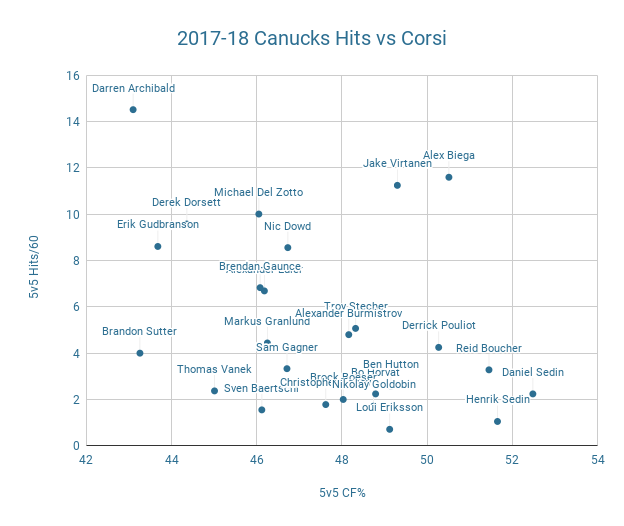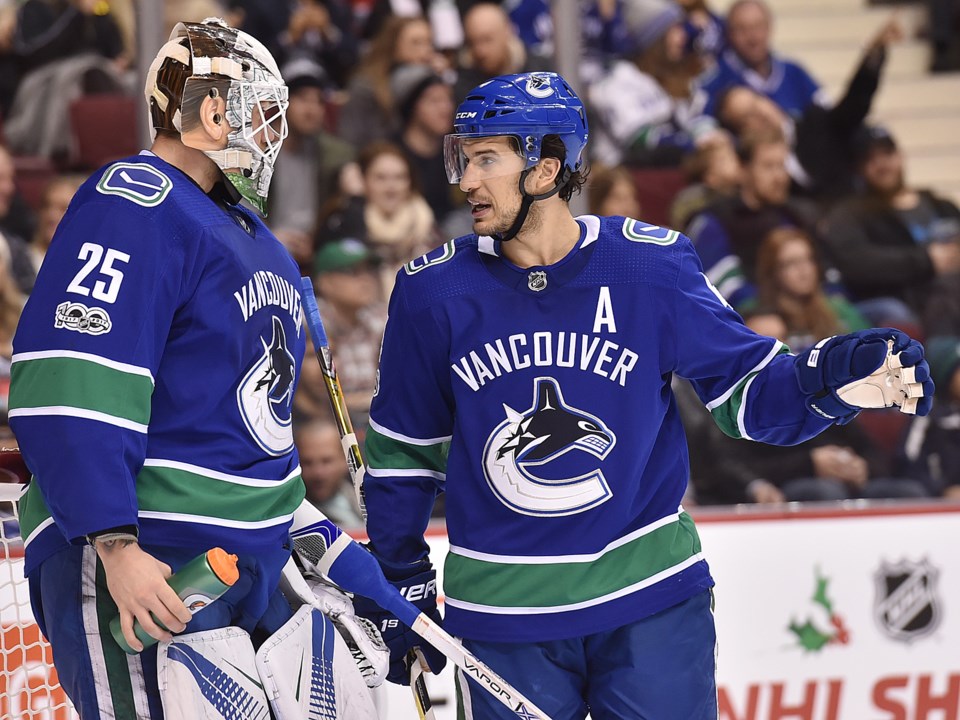Hockey is a physical sport. Hitting, in some form, will always be a part of the game and an important part: they’re key to separating a player from the puck, taking a player out of the play, or good old-fashioned intimidation.
Hits can also be tremendously entertaining. One of my favourite hockey moments ever was Jan Bulis wiping out Jack Johnson with a picture-perfect hip check in Johnson’s first NHL game. One of the best things in hockey is seeing a player get hit over the boards into the bench. A good clean hit can get the crowd out of their seats just as much as a goal.
So, it’s not surprising that the Vancouver Canucks, who didn’t have too many goals this season, would want to celebrate some hits. Accordingly, they posted a video of the best hits from the 2017-18 season.
It’s a decent highlight reel, with some big hits from the likes of Erik Gudbranson, Jake Virtanen, and others. I feel like it’s missing two of my favourite hits from the season, however, both from Ben Hutton.
There was this huge hit on Brooks Orpik that Devante Smith-Pelly took exception to…
...and this open-ice sit-down on Dustin Brown.

The Canucks Twitter account also crowed about a couple hit statistics when they posted the video. The Canucks finished the season with 1,745 hits, 274 more than last season. In addition, Michael Del Zotto was fifth in the NHL in hits with 244.
Reading the responses to that tweet reveal that certain analytical arguments have seeped into the mainstream, mainly that a high quantity of hits is generally inversely correlated to quality of play. In other words, if your team throws a lot of hits, your team probably isn’t very good.
It’s an intuitive argument, which is likely why it’s taken hold with a lot of hockey fans: if you’re hitting another player, you don’t have the puck. If you’re throwing a lot of hits — say, the fifth-most in the league — you don’t have the puck a lot.
This is a simplification, of course. There are players who never have the puck who also don’t hit, though a lot of them don’t last long in the NHL. Players need to prove their value to the team in some way, and if you neither possess the puck and provide offence nor throw hits and provide physicality, you have to come up with some other way to get in your coach’s good graces.
There are also good possession players who are more than willing to take the body. They tend to rack up hits, but not quite to the extent of those at the top of the NHL at the end of the season.
But, in general, a lot of hits usually means you’re a poor puck possession player and we can see that with a quick scatter plot of hits per 60 minutes vs corsi percentage. Both statistics are from 5-on-5 play.

We can see the relation pretty clearly: the players with the best corsi percentage have the lowest rate of hits and vice versa.
Sure enough, there’s Michael Del Zotto towards the top left of the chart. His corsi percentage isn’t as bad as that of Erik Gudbranson, but it’s still on the lower end for the Canucks and it’s matched by his high rate of hits.
What really jumps out at me, however, are the exceptions. Jake Virtanen and Alex Biega stand out for putting up pretty decent possession statistics, while still being two of the team leaders in hits. It’s important to keep in mind that Biega tended towards more sheltered minutes on the third pairing, which helps explain some of his corsi, but it’s still impressive that he threw hits at that rate while maintaining good possession numbers.
I’d be more inclined to celebrate someone like Virtanen over Del Zotto, for throwing hits at a higher rate than Del Zotto while putting up a much better corsi percentage.
At the other side is Brandon Sutter.
Sutter has a reputation for being a gritty player, but it always seemed to be a reputation borne from his size and name rather than how he plays on the ice. Sutter has never really been very physical on the ice and it shows up on the chart: despite the second-lowest corsi percentage on the team, he barely hits more than Reid Boucher.
That doesn’t mean that Sutter is a bad player — there’s an analytical deep dive to be done on Sutter’s extremely defensive usage this past season and how it affected his statistics — but it does throw a wrench into his narrative as a physical, gritty centre.
The solution to his isn’t to stop hitting: you can’t reverse engineer success that way. Several teams in the bottom-10 in hits this season missed the playoffs: the Chicago Blackhawks, Carolina Hurricanes, Detroit Red Wings, Calgary Flames, and Florida Panthers. But you can pursue players and a style of play that will lead to you having the puck more and needing to hit less.
We’re seeing in the playoffs this season that the big, physical teams are struggling to keep up with the speedy, skilled teams. The Anaheim Ducks and Los Angeles Kings, two of the teams in the playoffs with the most hits, were swept by the San Jose Sharks and Vegas Golden Knights in the first round.
The Tampa Bay Lightning are the lightest team in the NHL and finished the season with the league’s best goal differential and are one of the Cup favourites.
Even the big bad Boston Bruins are now one of the shortest teams in the NHL, with the 5’9” Brad Marchand and Torey Krug leading the team’s forwards and defencemen in scoring.
Don’t chase size and hits at the expense of puck possession and offence. Hits should be a part of your system designed to get the puck back and create offence. Players that throw a lot of hits but don’t contribute to puck possession are not actually doing anything useful.



